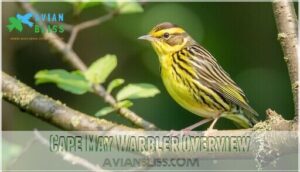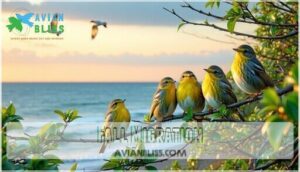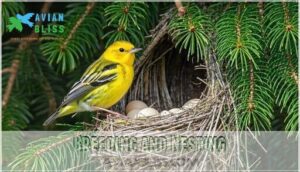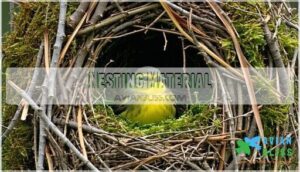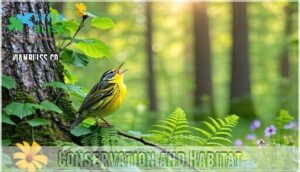This site is supported by our readers. We may earn a commission, at no cost to you, if you purchase through links.

It migrates from Canada to the Caribbean, clocking thousands of miles twice a year—no passport needed.
You might catch it munching on insects in summer or switching to fruit and nectar when winter rolls around.
The cape may warbler’s nest sits high up, hidden in dense needles, where it raises a clutch of speckled eggs.
Curious how climate change and habitat shifts affect their journey? There’s more to discover ahead.
Table Of Contents
- Key Takeaways
- Cape May Warbler Overview
- Migration Patterns
- Diet and Feeding Habits
- Breeding and Nesting
- Conservation and Habitat
- Frequently Asked Questions (FAQs)
- Are Cape May warblers rare?
- Where do Cape May Warblers live?
- What are some interesting facts about the Cape May Warbler?
- What is the difference between yellow rumped warbler and Cape May?
- Where do Cape May Warblers nest?
- How big is a Cape May Warbler?
- What is the niche of a Cape May Warbler?
- How did the Cape May Warbler get its name?
- What is unique about the Cape May Warblers tongue?
- Do Cape May Warblers compete with hummingbirds for resources?
- Conclusion
Key Takeaways
- You’ll spot Cape May Warblers by their tiger-striped yellow chest and chestnut ear patches, especially in males during breeding season.
- You’ll find them nesting high in spruce or fir trees across Canada, then migrating thousands of kilometers to winter in the Caribbean.
- You’ll notice their diet shifts from insects in summer to nectar and fruit in winter, thanks to their unique tubular tongue.
- You’ll see climate change and habitat loss threatening their numbers, with populations dropping by 70% since 1966.
Cape May Warbler Overview
You’ll quickly recognize the Cape May Warbler by its distinctive tiger-striped yellow breast and the male’s chestnut ear patches during breeding season.
This small songbird weighs just 9-13 grams with a 12-14 cm body length, making identification easier when you spot its characteristic yellow rump and bold black streaking.
Physical Characteristics
When you’re spotting a Cape May Warbler, you’ll notice distinct plumage patterns that set this warbler species apart from others.
The cape may warbler displays remarkable sexual dimorphism in feather colors and bird anatomy. Males showcase vibrant yellow underparts with bold black eye stripes, while their specialized beak shape helps with nectar feeding.
Key physical traits include:
- Body size: 12-14 cm length with 9-13 gram weight
- Distinctive markings: Tiger-striped breast patterns in breeding males
- Coloration: Bright yellow with chestnut ear patches (males only)
This bird identification becomes easier when you understand their bird physiology varies seasonally, with males losing their striking appearance outside breeding season.
Identification Features
You’ll recognize this cape may warbler through distinct visual clues that separate it from other warbler species.
Males sport striking breast patterns with bold black stripes across bright yellow underparts, while their face marks include chestnut ear patches and black eye stripes.
Wing bars appear as white patches on gray-brown wings, and their beak shape is slightly decurved for nectar feeding.
Understanding bird identification techniques is essential for distinguishing between similar species.
| Feature | Male | Female/Immature |
|---|---|---|
| Breast Patterns | Bold black tiger stripes on yellow | Faint streaks, muted colors |
| Face Marks | Chestnut ear patch, black eyeline | Gray cheeks, fainter markings |
| Wing Bars | White patches on gray wings | Similar but less distinct |
The key to accurate identification lies in noting these distinct visual clues and understanding how they vary between males and females or immature birds.
This knowledge helps in distinguishing between similar species, making bird watching more enjoyable and rewarding.
Size and Weight
When you encounter Cape May Warblers, you’ll notice they’re compact songbirds measuring 12-14 cm in body length.
These wood warblers weigh just 9-13 grams, making size comparison with other species straightforward.
Their petite build doesn’t diminish their striking color patterns during migration.
Key Size Measurements:
- Body Length: 12-14 cm (4.7-5.5 inches)
- Weight Range: 9-13 grams (0.3-0.5 ounces)
- Wingspan: 20-22 cm across
- Growth Patterns: Consistent measurements across breeding populations
Migration Patterns
You’ll witness one of nature’s most remarkable journeys as Cape May Warblers travel up to 3,000 kilometers between their breeding and wintering grounds.
These tiny powerhouses navigate thousands of kilometers twice yearly, proving size means nothing when determination drives the journey.
These small songbirds navigate from Canadian boreal forests to Caribbean islands twice yearly, often flying over 450 kilometers per night during favorable conditions, showcasing their incredible endurance and navigational skills, with remarkable journeys that highlight their ability to thrive in diverse environments.
Spring Migration
During spring migration, Cape May Warblers follow established migration routes primarily through Florida, then fan out northward and westward toward central Canada.
These wood warblers typically migrate at night, covering up to 450 kilometers in favorable conditions.
Peak seasonal timing occurs from April to early June, with birds utilizing key stopover sites along the Gulf and East Coasts when weather conditions challenge their flight patterns across their expansive geographic range.
Understanding bird migration patterns is essential for predicting their behavior and habitat use during this period.
Fall Migration
Cape May Warblers begin their fall migration in early August, with peak movements occurring through September.
You’ll spot them following migration routes along the Atlantic Coast, using key stopover sites to refuel.
These seasonal movements differ from spring patterns, as birds concentrate heavily along coastal areas, and fall patterns show many individuals lingering into late fall.
Making bird tracking easier for observers studying warbler migration dynamics.
Wintering Grounds
After crossing vast ocean stretches, Cape May warblers reach their Caribbean Islands destination, where winter habitat becomes essential for survival.
These wintering grounds span from Jamaica to Puerto Rico, offering essential fruit sources and nectar feeding opportunities.
The Caribbean’s flowering plants and ripening fruits provide critical nutrition during the non-breeding season, supporting warbler populations year-round, and bird conservation efforts focus on protecting these migration routes and tropical habitats that sustain them.
Migration Speed and Distance
These remarkable warblers cover impressive migration distance during their twice-yearly journeys between breeding and wintering grounds.
You’ll find them traveling up to 5,000 kilometers from northern Canada to the Caribbean, with daily flight patterns covering 200-300 kilometers when conditions align perfectly.
During warbler migration season, stopover sites become essential refueling stations where speed variations depend on weather and food availability.
Migration routes follow major flyways, with migratory birds maintaining average speeds of 50-60 kilometers daily throughout bird migration periods.
Diet and Feeding Habits
You’ll discover the Cape May Warbler’s remarkable dietary flexibility as it switches between insects, nectar, and fruit depending on the season.
This warbler’s specialized feeding adaptations allow it to thrive in diverse environments from breeding grounds to tropical wintering areas, showcasing its ability to adapt to different conditions with remarkable ease.
Breeding Diet
During breeding season, you’ll find these warblers becoming specialized insect hunters with remarkable precision.
Their warbler diet shifts dramatically to support breeding nutrition needs through intensive caterpillar feeding.
Here’s what drives their insect consumption:
- Spruce budworm caterpillars – their primary protein source during nesting
- Various moth larvae – supplementing their omnivorous diet requirements
- Spiders and beetles – providing essential nutrients for egg production
This insect diet directly correlates with breeding success, as spruce budworm outbreaks trigger population booms in Cape May Warblers.
Understanding proper insect feeder systems can help replicate their natural diet in controlled environments.
Migration Diet
During migration, you’ll find these warblers adapting their diet remarkably.
While insect feeding remains primary, nectar consumption and fruit eating become increasingly important for building energy reserves.
Their dietary adaptation includes sipping from flowers and piercing fruit for juice.
This warbler diet flexibility helps them survive long flights, with ecological cycles influencing available food sources along migration routes, which is crucial for their energy reserves and overall survival.
Winter Diet
When winter arrives, you’ll notice Cape May Warblers drastically change their dietary adaptation from insects to nectar intake and fruit consumption.
Their winter diet shifts dramatically as these birds pursue flowering plants and ripe fruits throughout the Caribbean.
Winter foraging involves defending prime nectar sources from hummingbirds while maintaining insect feeding when available, demonstrating remarkable dietary flexibility during harsh seasons with a focus on nectar intake.
Tongue Adaptation for Feeding
You’ll discover the Cape May Warbler’s curled tongue works like nature’s straw.
This tubular tongue adaptation lets them sip nectar from flowers and extract juice from soft fruits.
The specialized beak pierces fruit skin while the coiled tongue structure draws out sweet liquids.
This warbler behavior gives them access to food sources other birds can’t reach during migration.
Understanding their diet requires knowledge of proper Warbler Food sources, which is a critical aspect of their survival, and involves eating the right food sources.
Breeding and Nesting
You’ll find that Cape May Warblers have fascinating breeding habits tied closely to spruce budworm outbreaks in Canada’s boreal forests.
These small songbirds build their nests high in conifer trees and can lay unusually large clutches when food is abundant.
Breeding Season
You’ll find Cape May warblers beginning their breeding season from late May through July across Canada’s boreal forests.
Males arrive first to establish territories, defending roughly one-acre plots against rivals through aggressive displays and persistent singing. Breeding success depends heavily on spruce budworm availability, with females selecting mates based on territory quality and male vigor.
- Territorial Defense: Males fiercely guard prime nesting areas through vocal challenges and aerial pursuits
- Mate Selection: Females choose partners based on territory resources and male breeding plumage quality
- Reproductive Strategies: Larger clutches during budworm outbreaks maximize breeding success opportunities
Understanding the role of nest site selection is vital for the survival of these birds.
Nesting Sites
You’ll spot Cape May Warblers choosing their nesting sites with remarkable precision in Canada’s boreal forests.
These birds show strong site fidelity, returning to proven locations year after year.
Tree selection focuses on mature spruce and fir trees, typically 35-60 feet tall.
Habitat quality determines nest placement success, with dense foliage providing essential protection, and bird nesting behavior reveals their preference for conifer crowns against main trunks, showcasing their need for dense foliage and proven locations.
Nesting Material
Cape May Warblers craft their homes using nature’s finest building supplies.
These skilled architects gather specific materials to create cozy nurseries for their young.
Key nesting materials include:
- Moss and fine twigs – Primary structural foundation
- Grass, pine needles, and bark strips – Wall reinforcement
- Feathers and animal fur – Soft interior lining
- Small vines and rootlets – Binding elements
This warbler nesting strategy guarantees clutch size success through careful material gathering and nest construction in their bird habitat.
The use of proper bird nesting materials is vital for the survival of the species.
Nest Placement
Precision defines everything when you’re studying warbler nesting behavior.
Cape May Warblers choose their nest height strategically, placing nests 40-60 feet high in mature spruce or fir trees.
Their tree selection focuses on dense conifers with thick foliage for maximum nest camouflage.
Branch orientation typically positions nests against the trunk where multiple branches converge, providing maximum protection.
These placement strategies guarantee survival in challenging bird habitat conditions.
| Nest Height | Tree Selection | Branch Orientation |
|---|---|---|
| 40-50 feet average | Spruce preferred | Against trunk |
| Up to 60 feet maximum | Fir trees common | Multiple branch convergence |
| Higher than most warblers | Dense foliage essential | Protected from wind |
| Varies with tree availability | Mature conifers only | Camouflaged position |
| Altitude affects predation risk | Boreal forest species | Structural support critical |
Clutch Size and Incubation
Once you locate their high-altitude nests, you’ll discover Cape May Warblers produce impressive clutch sizes averaging six eggs per breeding attempt.
This clutch variation directly responds to food availability, with larger broods during spruce budworm outbreaks maximizing breeding outcomes through adaptive nesting success strategies.
The warblers’ breeding success is closely tied to spruce budworm abundance affecting their overall population dynamics.
- Egg laying occurs mid-to-late June, producing creamy white eggs with reddish-brown markings
- Incubation period lasts 11-13 days, performed exclusively by females using specialized warbler anatomy
- Bird breeding success correlates strongly with spruce budworm abundance affecting clutch size decisions
Conservation and Habitat
Understanding the Cape May Warbler’s habitat needs is essential for protecting this species as environmental changes threaten both their breeding and wintering grounds.
You’ll discover how climate shifts, habitat loss, and ecosystem changes directly impact their survival and what role these remarkable birds play in maintaining forest health.
Breeding Habitat
You’ll find these warblers thriving in Canada’s remote spruce-fir forests, where dense canopy coverage creates ideal breeding grounds.
Tree selection focuses on mature conifers reaching 35-60 feet, providing security from predators and abundant nesting sites.
However, habitat loss threatens these specialized breeding plumage displays, as forest density requirements make Cape May Warblers vulnerable to logging and climate shifts affecting warbler habitat and bird territoriality within forest ecology.
Wintering Habitat
Winter transforms these warblers into nectar specialists across Caribbean Islands.
You’ll find them defending flowering plants from hummingbirds, using specialized tongues for winter feeding.
Habitat loss threatens critical wintering grounds, disrupting migration routes.
Caribbean wintering populations face increasing pressure from development, making warbler conservation efforts essential for maintaining stable bird conservation programs throughout their range.
Population Distribution
You’ll find Cape May Warblers concentrated across a specific Geographic Range, with 83% of north american birds breeding in Canada’s boreal forests.
Population Trends show concerning declines of 2.5% annually since 1966, resulting in 70% fewer warbler populations.
Cape May Warblers have lost 70% of their population—a heartbreaking decline demanding immediate conservation action.
Density Patterns fluctuate dramatically based on spruce budworm outbreaks, creating boom-bust cycles in bird distribution.
The warblers’ survival depends on spruce budworm cycles and food availability.
- Your heart might sink knowing these striped beauties have lost 70% of their numbers
- Picture vast Canadian forests echoing with fewer warbler songs each spring
- Imagine future generations missing these tiger-striped gems during Migration Routes
Climate Vulnerability
Climate change threatens Cape May Warblers through multiple pathways.
Temperature Shift moves their breeding range 350 km northward by 2080, while Weather Extremes reduce fledgling survival by 13% during heat waves.
Habitat Loss affects 46% of current breeding areas by 2050.
Sea Level Rise and Ecosystem Disruption further challenge conservation status, requiring immediate bird conservation biology interventions to protect migration patterns against these escalating climate threats.
Role in Ecosystem
When you’re protecting forests, you’re safeguarding Cape May Warblers‘ essential ecosystem role.
These birds control spruce budworm populations, preventing devastating forest damage through natural pest management. Their seed dispersal activities promote forest regeneration while their nectar feeding supports pollination networks.
As key food web components, they transfer energy between forest canopy and understory levels, maintaining biodiversity balance that strengthens warbler ecology and guarantees healthy forest conservation outcomes.
Understanding the importance of habitats is vital for effective bird conservation strategies.
Frequently Asked Questions (FAQs)
Are Cape May warblers rare?
Like finding a rare coin in your pocket, spotting a Cape May warbler isn’t impossible, but you won’t see them every day.
They’re common during migration, especially near the Great Lakes, but less so elsewhere.
Where do Cape May Warblers live?
You’ll find Cape May Warblers nesting high in spruce and fir trees across Canada and the northern U.S.
During migration, they travel through Florida and the Atlantic Coast, then winter in the Caribbean, Central America, and northern South America, which is their primary wintering ground in the northern parts of this region.
What are some interesting facts about the Cape May Warbler?
You’ll spot males with tiger-striped yellow breasts and chestnut ear patches, while females look much duller.
They migrate huge distances, feed on insects and nectar, and nest high in spruce trees, laying up to nine eggs.
What is the difference between yellow rumped warbler and Cape May?
Cape May Warblers have a wingspan of 20–22 cm and a bright yellow breast with tiger stripes.
You’ll spot yellow-rumped warblers by their yellow rump and less streaked chest.
Both migrate long distances, but differ in plumage.
Where do Cape May Warblers nest?
You’ll see these warblers nesting high up in spruce or fir trees, tucked into thick foliage near the trunk.
They prefer remote boreal forests, choosing spots about 40 to 60 feet off the ground.
How big is a Cape May Warbler?
Good things come in small packages, and you’ll notice this bird measures about 12–14 centimeters long, with a wingspan of 20–22 centimeters.
Weighing just 9–13 grams, it’s a medium-sized warbler with a striking presence.
What is the niche of a Cape May Warbler?
You’ll find this warbler filling a unique niche by feasting on spruce budworms in northern forests, sipping nectar in the Caribbean, and nesting high in conifers.
Its flexible diet and migration habits let it thrive across changing seasons.
How did the Cape May Warbler get its name?
Imagine a birder spotting a striking warbler in New Jersey’s Cape May.
You’d call it Cape May Warbler too, since scientists first described it there.
Its name reflects where it was first identified, not where it lives.
What is unique about the Cape May Warblers tongue?
You’ll notice the Cape May Warbler’s tongue is curled and tubular, almost like a tiny straw.
This lets it sip nectar and fruit juice, giving it an edge when flowers are blooming and insects are scarce, with its unique feature being the tubular shape.
Do Cape May Warblers compete with hummingbirds for resources?
With migration speeds reaching 450 kilometers per night, Cape May Warblers fiercely guard flowering plants, often chasing off hummingbirds.
You’ll spot them defending nectar sources, showing they don’t shy away from a little competition for sweet rewards.
Conclusion
Don’t let the cape may warbler slip through your fingers—understanding its migration, diet, and nesting secrets helps you spot this unique bird.
You’ll notice its tiger-striped chest and clever nectar-feeding tongue if you’re patient.
Climate change and habitat shifts challenge its journey, so your awareness matters.
Whether you’re a backyard birder or a science enthusiast, keep an eye out for the cape may warbler’s seasonal travels and behaviors. Every observation adds to its fascinating story.
- https://wildadirondacks.org/adirondack-birds-cape-may-warbler-setophaga-tigrina.html
- https://app.birda.org/species-guide/35620/Cape_May_Warbler
- https://www.tn.gov/twra/wildlife/birds/forest-birds/cape-may-warbler.html
- https://extapps.dec.ny.gov/fs/programs/dfw/SWAP2025/Birds/Cape%20May%20warbler.pdf
- https://www.allaboutbirds.org/guide/Cape_May_Warbler/maps-range

